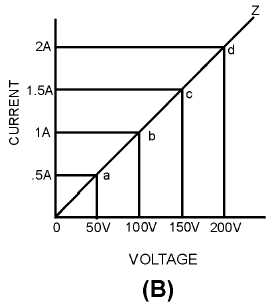1-12
Figure 1-4B.—Circuit with one linear impedance.
The principle of linear impedance can be extended by connecting two impedance devices in series,
as shown in figure 1-5, view (A). The characteristics of both individual impedances are determined as
explained in the preceding section. For example, assume voltmeter V1 shows 50 volts and the ammeter
shows 0.5 ampere. Point a in view (B) represents this ordinate. In the same manner, increasing the voltage
in increments of 50 volts gives points b, c, and d. Lines Z1 and Z2 show the characteristics of the two
impedances. The total voltage of the series combination can be determined by adding the voltages across
Z1 and Z2. For example, at 0.5 ampere, point a (50 volts) plus point e (75 volts) produces point i (125
volts). Also, at 1 ampere, point b plus point f produces point j. Line Z1 + Z2 represents the combined
voltage-current characteristics of the two devices.
Figure 1-5A.—Circuit with two linear impedances.



